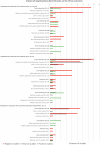Operating room organization and surgical performance: a systematic review
- PMID: 38287316
- PMCID: PMC10826254
- DOI: 10.1186/s13037-023-00388-3
Operating room organization and surgical performance: a systematic review
Abstract
Background: Organizational factors may influence surgical outcomes, regardless of extensively studied factors such as patient preoperative risk and surgical complexity. This study was designed to explore how operating room organization determines surgical performance and to identify gaps in the literature that necessitate further investigation.
Methods: We conducted a systematic review according to PRISMA guidelines to identify original studies in Pubmed and Scopus from January 1, 2000 to December 31, 2019. Studies evaluating the association between five determinants (team composition, stability, teamwork, work scheduling, disturbing elements) and three outcomes (operative time, patient safety, costs) were included. Methodology was assessed based on criteria such as multicentric investigation, accurate population description, and study design.
Results: Out of 2625 studies, 76 met inclusion criteria. Of these, 34 (44.7%) investigated surgical team composition, 15 (19.7%) team stability, 11 (14.5%) teamwork, 9 (11.8%) scheduling, and 7 (9.2%) examined the occurrence of disturbing elements in the operating room. The participation of surgical residents appeared to impact patient outcomes. Employing specialized and stable teams in dedicated operating rooms showed improvements in outcomes. Optimization of teamwork reduced operative time, while poor teamwork increased morbidity and costs. Disturbances and communication failures in the operating room negatively affected operative time and surgical safety.
Conclusion: While limited, existing scientific evidence suggests that operating room staffing and environment significantly influences patient outcomes. Prioritizing further research on these organizational drivers is key to enhancing surgical performance.
Keywords: Disturbing elements; Familiarity; Scheduling; Staffing; Surgery; Teamwork; Turn over; Workload.
© 2024. The Author(s).
Conflict of interest statement
The authors declare no competing interests.
Figures




References
Publication types
Grants and funding
LinkOut - more resources
Full Text Sources
Miscellaneous

